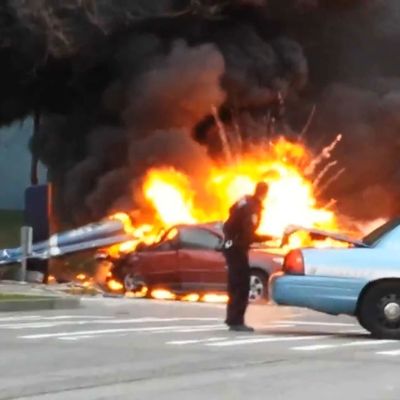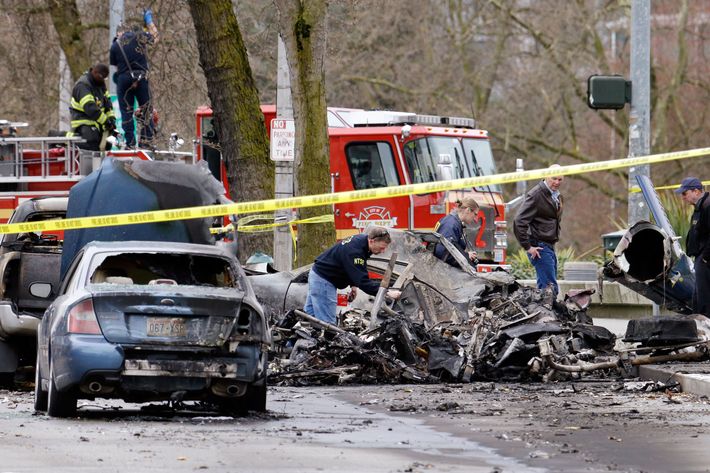
On Tuesday, a news helicopter for Seattle’s KOMO-TV took off from the station’s rooftop helipad, caught fire, fell to the street, and crashed near the Space Needle, setting two cars on fire and killing two men onboard the chopper and a third on the ground. It was, by local news standards, a horrible yet mundane tragedy, part of the cost of doing business. Local TV news uses choppers, and sometimes choppers crash.
Still, I think moments like these ought to make the TV news business take stock of how it gathers news, and ask if there might be a safer and more cost-effective way to do it. Based on past experience writing about these kinds of tragedies — including the 2004 crash of a WNBC helicopter in Brooklyn ten years ago — I can’t imagine it will.
But I’m going to bang the drum one more time here anyway, for old time’s sake, and assert that most of the helicopter footage that we see on local newscasts is journalistically unnecessary eye candy, gathered at great expense under physically risky circumstances.
Before we go any further down this road, let’s get a few statistics out of the way — and while we’re doing it, let’s establish that, as Superman once put it, statistically speaking, flying is still the safest way to travel.

At least 18 people have been killed and 19 injured in 25 separate news-chopper mishaps since 2000, including the Brooklyn rooftop crash in 2004 and a 2007 mid-air collision between two news helicopters over Phoenix. The crashes occurred in all manner of situations, from covering tornadoes or search-and-rescue operations or simply getting from point A to point B; considering that every U.S. news market has multiple news choppers in the air multiple times each day, logging untold numbers of flight hours each year, that’s not a statistically shocking average.
Nevertheless, if you weigh the cost of news-chopper coverage against what news stations actually get out of it, the practice starts to look less like a journalistic necessity than a habit that nobody can imagine breaking.
According to news-chopper photographers who spoke to Intelligencer off-the-record, it costs news stations anywhere from $600,000—$1 million a year to maintain a chopper that’s constantly at the ready. That price tag includes the costs of fuel and maintenance, berthing/hangar costs, and two pilots. A staff videographer operating the camera costs another $60,000—$100,000 a year, or half that if the station hires freelancers.
That’s a lot of money to cumulatively sink into chopper-cam footage: $4 to $8 million a year in markets with a lot of affiliate stations. And for every ratings-spiking, career-defining shot that only a news chopper could have captured, you get dozens or hundreds of airborne shots of the exteriors of buildings where something vaguely newsworthy happened hours ago: an extraordinarily dramatic view of nothing special.
Local news directors could argue that if it ain’t broke, there’s no reason to fix it, and in purely mercenary terms, they wouldn’t be wrong. The Pew Research Center recently published a report that “describes cutbacks in the reporting ranks of newspapers and television networks and a surge in efforts by politicians, corporations and others to tell their own stories.” While ratings dipped a bit between 2012 and 2013, local news remains a top source of news overall.
At the same time, though, the Pew report concluded that there was “less in-depth journalism being produced” by local news outlets overall. If a typical local news market had $4 million to $8 million more to throw at newsgathering — money saved by not having a helicopter fueled and staffed and perpetually ready to go cover the same mostly non-stories that every other local station is also covering — just think of how much deeper and more useful a typical half-hour newscast could be.
In recent years, some local news organizations began sharing helicopters. Such an arrangement makes both financial and journalistic sense, given the tedious redundancy in airborne footage you see if you channel-hop during local newcasts. The chopper that crashed in Seattle on Tuesday was involved in such an arrangement. One can envision a situation wherein several local news stations in a major market share just one or two choppers, freeing up millions to pour into old-fashioned shoe-leather reporting.
Intelligencer repeatedly contacted news directors and assistant news directors at local news stations this week to ask them what they thought of all this — particularly the idea that the money poured into chopper cams is money that could be more productively spent elsewhere. They all declined to comment.
Additional reporting by Josef Adalian and Brennan Carley.






























